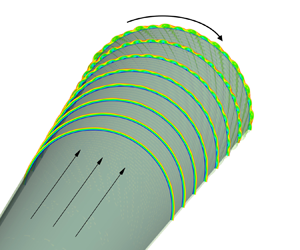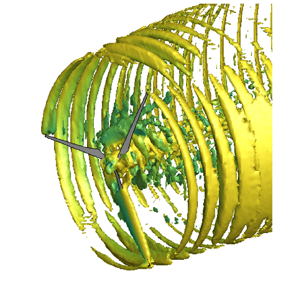Refine listing
Actions for selected content:
1418807 results in Open Access
Effect of cone rotation on the nonlinear evolution of Mack modes in supersonic boundary layers
-
- Journal:
- Journal of Fluid Mechanics / Volume 971 / 25 September 2023
- Published online by Cambridge University Press:
- 12 September 2023, A4
-
- Article
- Export citation
Introducing CNN-LSTM network adaptations to improve remaining useful life prediction of complex systems
- Part of
-
- Journal:
- The Aeronautical Journal / Volume 127 / Issue 1318 / December 2023
- Published online by Cambridge University Press:
- 12 September 2023, pp. 2143-2153
-
- Article
-
- You have access
- Open access
- HTML
- Export citation
CHRISTIANITY AND CONSTANTINE'S IMPERIAL WOMEN
-
- Journal:
- Greece & Rome / Volume 70 / Issue 2 / October 2023
- Published online by Cambridge University Press:
- 12 September 2023, pp. 218-237
- Print publication:
- October 2023
-
- Article
- Export citation
Latin literature
-
- Journal:
- Greece & Rome / Volume 70 / Issue 2 / October 2023
- Published online by Cambridge University Press:
- 12 September 2023, pp. 313-322
- Print publication:
- October 2023
-
- Article
-
- You have access
- Open access
- HTML
- Export citation
The Deterrent Effect of Whistleblowing on Insider Trading
-
- Journal:
- Journal of Financial and Quantitative Analysis / Volume 59 / Issue 8 / December 2024
- Published online by Cambridge University Press:
- 12 September 2023, pp. 3739-3769
- Print publication:
- December 2024
-
- Article
-
- You have access
- Open access
- Export citation
Roman history
-
- Journal:
- Greece & Rome / Volume 70 / Issue 2 / October 2023
- Published online by Cambridge University Press:
- 12 September 2023, pp. 328-342
- Print publication:
- October 2023
-
- Article
-
- You have access
- Open access
- HTML
- Export citation
GAR series 2 volume 70 issue 2 Cover and Back matter
-
- Journal:
- Greece & Rome / Volume 70 / Issue 2 / October 2023
- Published online by Cambridge University Press:
- 12 September 2023, pp. b1-b7
- Print publication:
- October 2023
-
- Article
-
- You have access
- Export citation
Characterization of energy transfer and triadic interactions of coherent structures in turbulent wakes
-
- Journal:
- Journal of Fluid Mechanics / Volume 971 / 25 September 2023
- Published online by Cambridge University Press:
- 12 September 2023, A7
-
- Article
- Export citation
MF, ZF, and MMSE filters for automotive OFDM radar
-
- Journal:
- International Journal of Microwave and Wireless Technologies / Volume 15 / Issue 10 / December 2023
- Published online by Cambridge University Press:
- 12 September 2023, pp. 1649-1655
-
- Article
- Export citation
Subsidizing Failing Firms: Evidence from Chinese Restaurants
-
- Journal:
- Journal of Financial and Quantitative Analysis / Volume 59 / Issue 8 / December 2024
- Published online by Cambridge University Press:
- 12 September 2023, pp. 3803-3834
- Print publication:
- December 2024
-
- Article
- Export citation
WHY CAN'T TELEMACHUS BE KING? THE GROWTH OF A YOUNG BASILEUS
-
- Journal:
- Greece & Rome / Volume 70 / Issue 2 / October 2023
- Published online by Cambridge University Press:
- 12 September 2023, pp. 289-308
- Print publication:
- October 2023
-
- Article
-
- You have access
- Open access
- HTML
- Export citation
Entry and leaving arcs of turnpikes: their exact computation in the calculus of variations
- Part of
-
- Journal:
- Canadian Mathematical Bulletin / Volume 67 / Issue 1 / March 2024
- Published online by Cambridge University Press:
- 12 September 2023, pp. 227-243
- Print publication:
- March 2024
-
- Article
-
- You have access
- Open access
- HTML
- Export citation
Human-induced mortality an overlooked threat for raptors in Nepal
-
- Journal:
- Bird Conservation International / Volume 33 / 2023
- Published online by Cambridge University Press:
- 12 September 2023, e73
-
- Article
-
- You have access
- HTML
- Export citation
Deynekoite, Ca9□Fe3+(PO4)7 – a new mineral of the merrillite group from phosphide-bearing contact facies of paralava, Hatrurim Complex, Daba-Siwaqa, Jordan
-
- Journal:
- Mineralogical Magazine / Volume 87 / Issue 6 / December 2023
- Published online by Cambridge University Press:
- 11 September 2023, pp. 943-954
-
- Article
- Export citation
Holocene millennial-scale variability of coastal environments on the southern coast of Korea and its controlling factors
-
- Journal:
- Quaternary Research / Volume 116 / November 2023
- Published online by Cambridge University Press:
- 11 September 2023, pp. 46-59
-
- Article
- Export citation
The Taming of the Grounds – ERRATUM
-
- Journal:
- Canadian Journal of Philosophy / Volume 53 / Issue 1 / January 2023
- Published online by Cambridge University Press:
- 11 September 2023, p. 101
-
- Article
-
- You have access
- Open access
- HTML
- Export citation
ATMOSPHERIC CO2 CARBON ISOTOPE COMPOSITION IN URBAN AND CLEAN AREAS OF THE NORTHERN ADRIATIC COAST OF CROATIA
-
- Journal:
- Radiocarbon / Volume 66 / Issue 5 / October 2024
- Published online by Cambridge University Press:
- 11 September 2023, pp. 989-1005
- Print publication:
- October 2024
-
- Article
- Export citation
A Novel Presenilin-1 Mutation (Leu226Val) In Early Onset Alzheimer’s Disease With Parkinsonism
-
- Journal:
- Canadian Journal of Neurological Sciences / Volume 51 / Issue 5 / September 2024
- Published online by Cambridge University Press:
- 11 September 2023, pp. 703-706
-
- Article
-
- You have access
- HTML
- Export citation
There’s no time like the present: path-dependent urban growth, agglomeration economies and congestion externalities in contemporary Athens
-
- Journal:
- Urban History / Volume 51 / Issue 3 / August 2024
- Published online by Cambridge University Press:
- 11 September 2023, pp. 633-653
-
- Article
-
- You have access
- Open access
- HTML
- Export citation
THREE SETS OF SHACKLES AT OLD SARUM, THE ‘ARREST OF THE BISHOPS’ IN 1139 AND THE POWER OF SHAMING IN THE ANGLO-NORMAN WORLD
-
- Journal:
- The Antiquaries Journal / Volume 103 / October 2023
- Published online by Cambridge University Press:
- 11 September 2023, pp. 195-214
- Print publication:
- October 2023
-
- Article
-
- You have access
- Open access
- HTML
- Export citation











